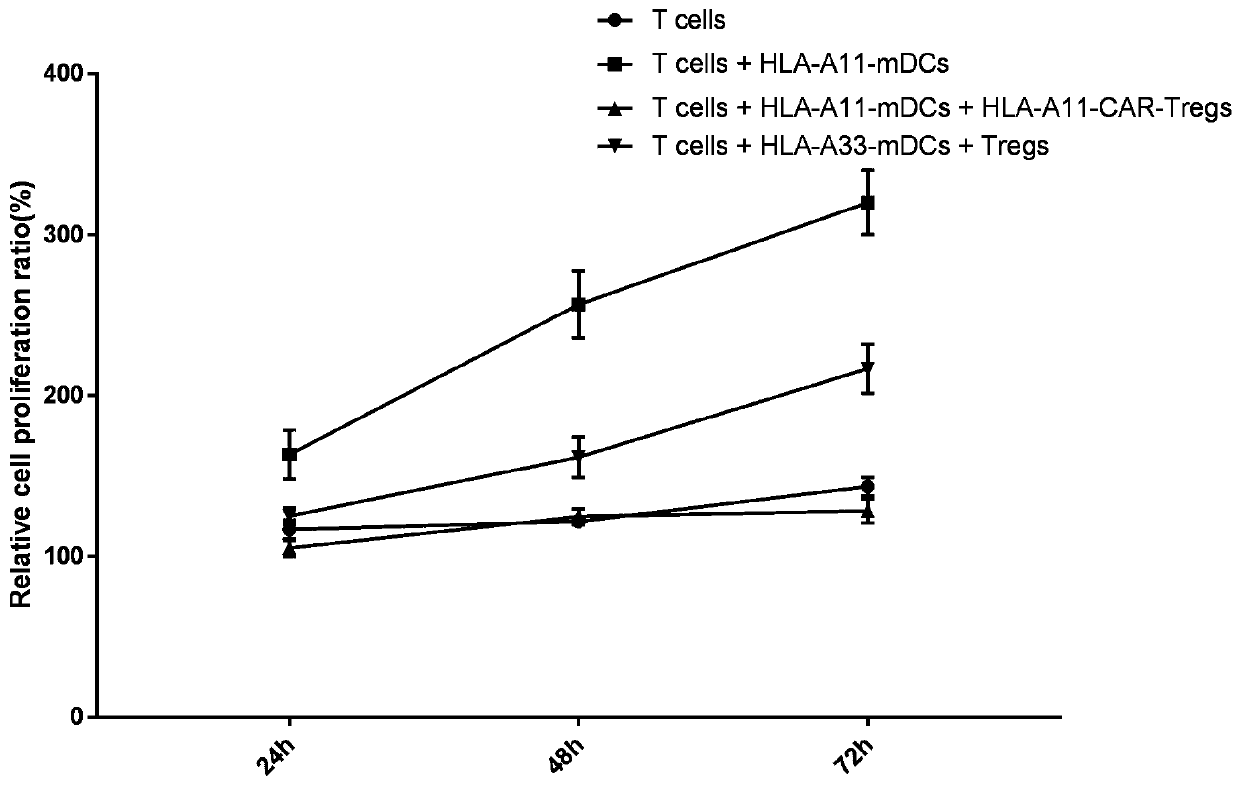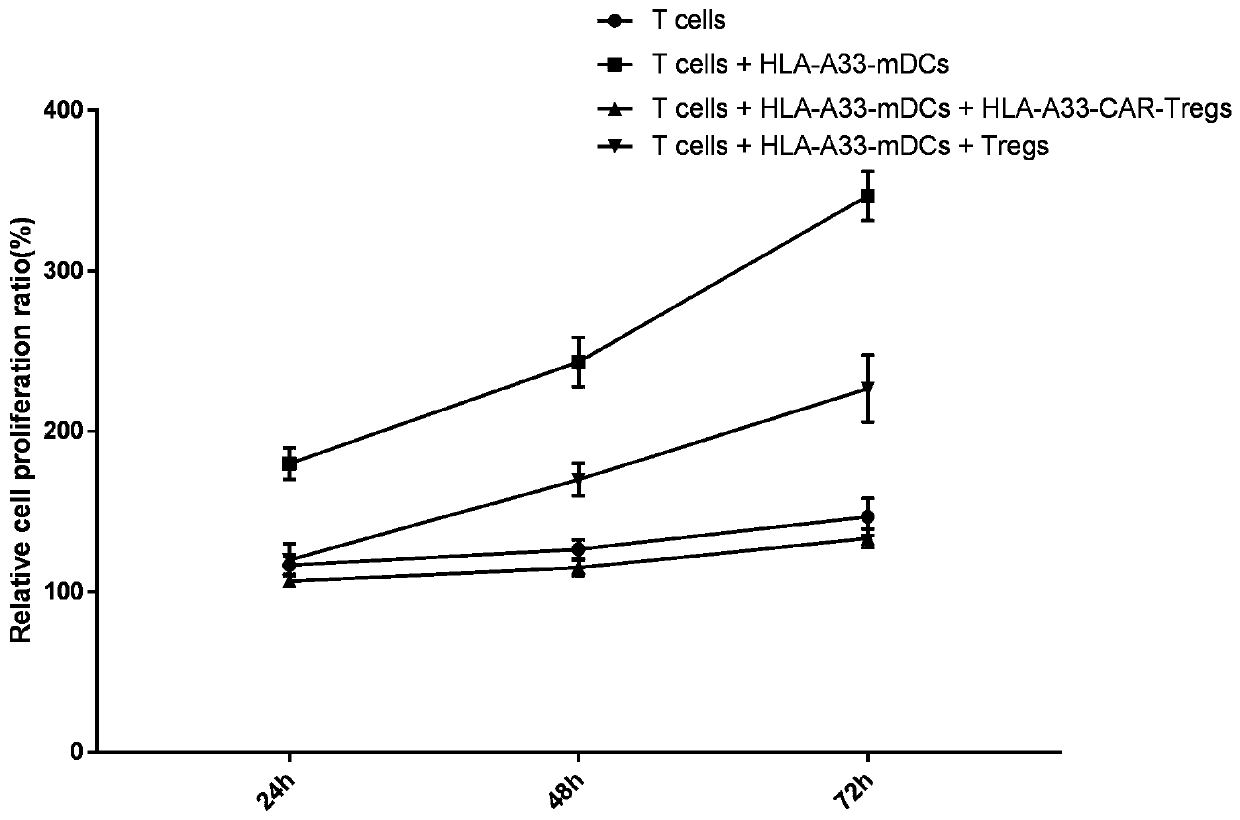Chimeric antigen receptor targeting HLA-A, encoding gene, CAR-Tregs cells, and preparation method and application of CAR-Tregs cells
A chimeric antigen receptor and HLA-A technology, applied in the field of molecular genes, can solve the problems of increased risk of tumors and infections, and low specificity.
- Summary
- Abstract
- Description
- Claims
- Application Information
AI Technical Summary
Problems solved by technology
Method used
Image
Examples
preparation example Construction
[0057] The present invention also provides a CAR-Tregs cell, and the CAR-Tregs cell is the Treg cell modified by the above-mentioned chimeric antigen receptor. The present invention also provides a method for preparing the above-mentioned CAR-Tregs cells, comprising: transfecting the chimeric antigen receptor into Treg cells for expression through its encoded nucleic acid sequence.
[0058] Preferably, the preparation method specifically includes:
[0059] (1) Construction of a chimeric antigen receptor lentiviral expression plasmid targeting HLA-A;
[0060] (2) Preparation of chimeric antigen receptor lentivirus targeting HLA-A;
[0061] (3) Transfect Treg cells with the chimeric antigen receptor lentivirus targeting HLA-A prepared in step (2).
[0062] The present invention provides the application of the above-mentioned CAR-Tregs cells in the preparation of drugs for treating or preventing transplant rejection and graft-versus-host disease, or in the preparation of drugs ...
Embodiment 1
[0065] 1. Construction of lentiviral expression plasmid
[0066] 1. Preparation of coding gene sequence of chimeric antigen receptor
[0067] Preparation of CD8 signal peptide, single-chain antibody targeting HLA-A11, CD8α hinge region, CD8 transmembrane region, 4-1BB hinge region, 4-1BB transmembrane region, 4-1BB intracellular signaling domain and CD3ζ signaling domain coding genes;
[0068] The single-chain antibody targeting HLA-A11 includes a tandem HLA-A11 single-chain antibody heavy chain VH, a connecting peptide, and an HLA-A11 single-chain antibody light chain VL; the HLA-A11 single-chain antibody heavy chain VH is located in the target HLA - the N-terminal of the single-chain antibody of A11, the light chain VL of the HLA-A11 single-chain antibody is located at the C-terminal of the single-chain antibody targeting the HLA-A11; the gene encoding the heavy chain VH of the HLA-A11 single-chain antibody is as shown in SEQ ID NO The nucleotide sequence shown in .1, the ...
Embodiment 2
[0118] The only difference between this example and Example 1 is that the HLA-A33-targeting single-chain antibody is used to replace the HLA-A11-targeting single-chain antibody, and finally HLA-A33-CAR-Tregs are obtained.
[0119] Wherein, the single-chain antibody targeting HLA-A33 includes a tandem HLA-A33 single-chain antibody heavy chain VH, a connecting peptide, and an HLA-A33 single-chain antibody light chain VL; the HLA-A33 single-chain antibody heavy chain VH is located at the target To the N-terminus of the single-chain antibody of HLA-A33, the light chain VL of the HLA-A33 single-chain antibody is located at the C-terminus of the single-chain antibody targeting the HLA-A33; the gene encoding the heavy chain VH of the HLA-A33 single-chain antibody is as shown in SEQ The nucleotide sequence shown in ID NO.3, the nucleotide sequence shown in SEQ ID NO.4 of the HLA-A33 single-chain antibody light chain VL coding gene; the connecting peptide coding gene is shown in SEQ ID ...
PUM
 Login to View More
Login to View More Abstract
Description
Claims
Application Information
 Login to View More
Login to View More - R&D
- Intellectual Property
- Life Sciences
- Materials
- Tech Scout
- Unparalleled Data Quality
- Higher Quality Content
- 60% Fewer Hallucinations
Browse by: Latest US Patents, China's latest patents, Technical Efficacy Thesaurus, Application Domain, Technology Topic, Popular Technical Reports.
© 2025 PatSnap. All rights reserved.Legal|Privacy policy|Modern Slavery Act Transparency Statement|Sitemap|About US| Contact US: help@patsnap.com



